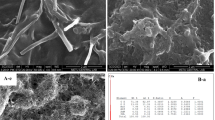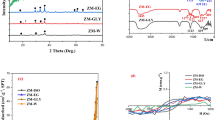Abstract
Four DNA electrochemical biosensors using four types of DNA (calf thymus ssDNA, calf thymus dsDNA, salmon testis ssDNA and salmon testis dsDNA) were constructed using graphite screen printed electrodes. These biosensors were exploited as analytical tool to detect polycyclic aromatic hydrocarbons-DNA interactions using benzo(a)anthracene and phenantrene as model analytes, the guanine oxidation peak variation being the signal revealing the interaction between PAHs and immobilized DNA. The salmon testis ssDNA biosensor resulted as the most promising device and was further evaluated for benzo(a)anthracene, fluorene, indeno(1,2,3-cd)pyrene, anthracene, and phenanthrene in 5–40 ng mL−1 solutions, and for benzo(a)pyrene (5–50 ng mL−1). A concentration dependent variation of the DNA guanine oxidation peak was observed for all compounds. The effect of benzo(a)pyrene ultraviolet (UV) activation on the benzo(a)pyrene (BaP)-DNA interaction was evaluated at concentration levels of 20 and 50 ng mL−1, and a 3.5- and 2.7-fold increases of the guanine oxidation peak was measured respectively. The salmon testis ssDNA biosensor was examined with PAHs contaminated samples of Mytilus galloprovincialis. Upon UV irradiation of three sample extracts exceeding the BaP maximum level, a positive variation of the DNA guanine oxidation was obtained. An average 2.4-fold increase of the guanine oxidation peak was detected demonstrating that the sensor can be used to detect toxic degradation products of PAHs.




Similar content being viewed by others
References
Vives I, Grimalt JO, Fernandez P, Rosseland B (2004) Polycyclic aromatic hydrocarbons in fish from remote and high mountain lakes in Europe and Greenland. Sci Total Environ 324:67–77
McElroy AE, Farrington JW, Teal JM (1989) Metabolism of polycyclic aromatic hydrocarbons in the aquatic environment Varanasi U Bioavailability of polycyclic aromatic hydrocarbons in the aquatic environment. CRC Boca Raton 1–39
Martinez E, Gross M, Lacorte S, Barcelò D (2004) Simplified procedures for the analysis of polycyclic aromatic hydrocarbons in water, sediments and mussels. J Chromatogr A 1047:181–188
Jonsson G, Bechmann RK, Bamber SD, Baussant T (2004) Bioconcentration, biotransformation, and elimination of polycyclic aromatic hydrocarbons in sheepshead minnows (Cyprionadon variegates) exposed to contaminated seawater. Environ Toxicol Chem 23:1538–1548
Billiard SM, Hahn ME, Franks DG, Peterson RE, Bols NC, Hodson PV (2002) Binding of polycyclic aromatic hydrocarbons (PAHs) to teleost aryl hydrocarbon receptors (AHRs). Comp Biochem Physiol B Biochem Mol Biol 133:55–68
Toyooka T, Ibuki Y (2007) DNA damage induced by co-exposure to PAHs and light. Environ Toxicol Pharmacol 23:256–263
Hatch AC, Burton Jr GA (1999) Photo-induced toxicity of PAHs to Hyalella azteca and Chironomus tentans: effects of mixtures and behavior. Environ Pollut 106:157–167
Tuveson RW, Wang GR, Wang TP, Kagan J (1990) Light dependent cytotoxic reactions of anthracene. Photochem Photobiol 52:993–2001
Zang S, Li P, Li W, Zhang D, Hamilton A (2007) Degradation mechanism of benzo[a]pyrene and its accumulated metabolites by biodegradation combined with chemical oxidation. Chemosphere 67:1368–1374
An YJ, Carraway ER (2002) PAH degradation by UV/H2O2 in perfluorinated surfactant solution. Water Research 36:309–314
Dunn BP (1991) Carcinogen adducts as an indicator for the public health risks of consuming carcinogen-exposed fish and shellfish. Environ Health Perspect 90:111–116
Livingstone DR (1994) Recent development in marine invertebrate organic xenobiotic metabolismToxicol Ecotoxicol News 1:88–95
Knutzen J (1995) Effects on marine organisms from polycyclic aromatic hydrocarbons (PAH) and other constituents of waste water from aluminium smelter with examples from Norway. Sci Total Environ 163:107–122
Frenzilli G, Bocchetti R, Pagliarecci M, Nigro M, Annarumma F, Scarcelli V, Fattorini D, Regoli F (2004) Time-course evaluation of ROS-mediated toxicity in mussels, Mytilus galloprovincialis, during a field translocation experiment. Marine Environ Research 58:2–5
Lucarelli F, Kicela A, Palchetti I, Marrazza G, Mascini M (2002) Electrochemical DNA biosensors for analysis of wastewater samples. Bioelectrochemistry 58:113–118
Wang J, Chicarro M, Rivas G, Cai X, Dontha N, Farias PAM, Shirashi H (1996) DNA biosensor for the detection of hydrazines. Anal Chem 68:2251–2254
Marrazza G, Chianella I, Mascini M (1999) Disposable DNA electrochemical biosensors for environmental monitoring. Anal Chim Acta 387:297–307
Bagni G, Osella D, Sturchio E, Mascini M (2006) Deoxyribonucleic acid (DNA) biosensors for environmental risk assessment and drug studies. Anal Chim Acta 574:81–89
Lucarelli F, Palchetti I, Marrazza G, Mascini M (2002) Electrochemical DNA biosensors as screening tool for the detection of toxicants in water and wastewater samples.Talanta 56:949–957
Meric B, Kerman K, Ozkan D, Kara P, Erdem A, Kucukoglu O, Erciyas E, Ozsoz M (2002) Electrochemical biosensor for the interaction of DNA with the alkylating agent 4,4′-dihydroxy chalcone based on guanine and adenine signals. J Pharm Biomed Anal 30(4):1339–1346
Wang J, Ozsoz M, Cai X, Rivas G, Shiraishi H, Grant DH, Chicarro M, Fernandes JR, Palecek E (1998) Interactions of antitumor drug daunomycin with DNA in solution and at the surface. Bioelectrochem Bioenerg 33–40
Chiti G, Marrazza G, Mascini M (2001) Electrochemical DNA biosensor for environmental monitoring. Anal Chim Acta 427:155–164
Kerman K, Meric B, Ozkan D, Kara P, Erdem A, Ozsov M (2001) Electrochemical DNA biosensor for the determination of benzo[a]pyrene—DNA adducts Anal Chim Acta 450:45–52
Shemer H, Linden KG (2007) Photolysis, oxidation and subsequent toxicity of a mixture of polycyclic aromatic hydrocarbons in natural waters. J Photochem Photobiol 187:186–195
Shemer H, Linden KG (2007) Aqueous photodegradation and toxicity of the polycyclic aromatic hydrocarbons fluorene, dibenzofuran and dibenzothiophene. Wat Res 41:853–861
Viarengo A, Canesi L (1991) Mussels as biological indicators of pollution. Aquaculture 94:225–243
Author information
Authors and Affiliations
Corresponding author
Electronic supplementary material
Below is the link to the electronic supplementary material.
Supplementary Section
(DOC 57.0 kb)
Rights and permissions
About this article
Cite this article
Del Carlo, M., Di Marcello, M., Perugini, M. et al. Electrochemical DNA biosensor for polycyclic aromatic hydrocarbon detection. Microchim Acta 163, 163–169 (2008). https://doi.org/10.1007/s00604-008-0009-2
Received:
Accepted:
Published:
Issue Date:
DOI: https://doi.org/10.1007/s00604-008-0009-2




